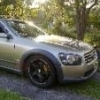R33 Intake Plenum
Announcements
-
Similar Content
-
Latest Posts
-
The hot exhaust light will come on not from just the cat being blocked, but it's just a temp sensor, and it's designed to warn you to not do things like park in long grass. If you've been pushing the motor a bit, it can cause the light to come on. Second if the cat is rattling, I'd suspect it's not blocked, but instead falling apart inside. The easiest "fix" until you can get a cat put back in, is to unbolt your one, bash the rest of the insides out, and then bolt it back in. For a daily driver/street car, I am in agreeance of put a cat in the car. If it were race car I wouldn't care if it were removed.
-
No worries at all 🫡 I think the most satisfying things to make are the little bits that are just impossible to find or they're no longer manufactured. Generally I always try to replace parts with OEM wherever possible. This little project is also great because it'll never see the light of day, but strengthen these brackets so it's not just relying on the little standard screws in the headlight plastic. As soon as I saw the standard brackets and screws I thought, "well I'm not going to install with just the screws, the plastic tabs will just snap off". It's crazy how expensive everything has become yeah. But I suppose that's supply and demand; granted it's a lot easier to get brand new genuine parts these days which is fantastic 😊, I don't have to get totally reamed at the local Nissan dealer ha ha We sure are lucky we have all these manufacturers making parts these days, a few really great Australian companies too like Platinum Racing Products and Fit Mint Automotive, what a time to be alive ❤️ . I've got my eye on the RB26 head by PRP as mine has a very fine hairline crack, so that'll need to be addressed some time in the future. If you have any requests or odd things to make feel free to let me know and I can have a crack at making replacement parts ✌️
-
Thanks for sharing this, and BTW if your headlights are in good condition they are worth thousands....you might want to consider replacing them with brand new LED ones like this (https://www.nengun.com/78works/full-led-headlights-r32-skyline) and making enough profit to buy a house in Sydney
-
I'm not sure what sort of shops are nearby, but I'd expect any reasonable exhaust shop could put a cat in it that will not restrict the power that engine makes. Otherwise, if you want to remove it, short lengths that replace the cat are readily available online, search for "de-cat pipes" or "test pipes"
-
Howdy friends, So another weird one today, I was looking into replacing some broken clips holding the front grille for the R32 GTR (part number 01553-03831), and noticed the brackets which are supposed to hold the grille in place were also missing 😑. I do recall seeing this issue many years ago, but didn't fix it at the time. A quick look on eBay and I was able to find the genuine brackets, along with all the screws which suited the headlights (part numbers 26042-08U05,26092-08U05). Happy days!.... Once they arrived however there was an extra nut in the packaging which implied that there should also be a bolt or a stud, and sure enough, after a bit of searching I found this thread from 2013, and @Ants clearly shows a stud should be present. Reading around a bit more, it's possible the headlights on my car are the "povo pack" headlights as mentioned by @funkymonkey in this thread way back in 2008. This could explain why the studs are missing on my set of headlights. Looking at the headlight diagram I wasn't able to see a suitable part number for the stud itself. The headlight did indeed have a recess that looked like it would accept a stud, but interestingly no thread or anything obvious how the stud would be affixed to the headlight, I suspect it may have been glued in, press fit, or melted into the plastic at the factory. Another member may be able to clarify if they happen to have a genuine set of N1 headlamps. The only thing we have to work with within the recess is a keyway which likely is there to prevent the stud from rotating within the recess. In any case, back to 3D printing, I put together a model which acts like a pug with a friction fit inside this recess, making use of the keyway so it doesn't rotate while tightening a bolt. Printing in TPU will allow it to slightly swell making a nice snug fit without cracking the part. I've designed the adaptor it to accept an 20 mm M6 bolt (stainless with a cap head in my case), as opposed to the standard M5 stud and I made use of the standard galvanised split washer that came with the genuine brackets from Nissan. Once the bolt and screws were all in place, giving the bracket a gentle shake gave the classic "shaking the car" feeling, very solid, which gives me confidence this is going to be able to hold on much better than the janky solution which seems to have been here for the past decade or so. Overall I'm really pleased with how this turned out and maybe there are more people out there running these headlights without a centre stud at all! Link to the freely available model on Printables: Click here Regards, Sean
-





Recommended Posts
Create an account or sign in to comment
You need to be a member in order to leave a comment
Create an account
Sign up for a new account in our community. It's easy!
Register a new accountSign in
Already have an account? Sign in here.
Sign In Now